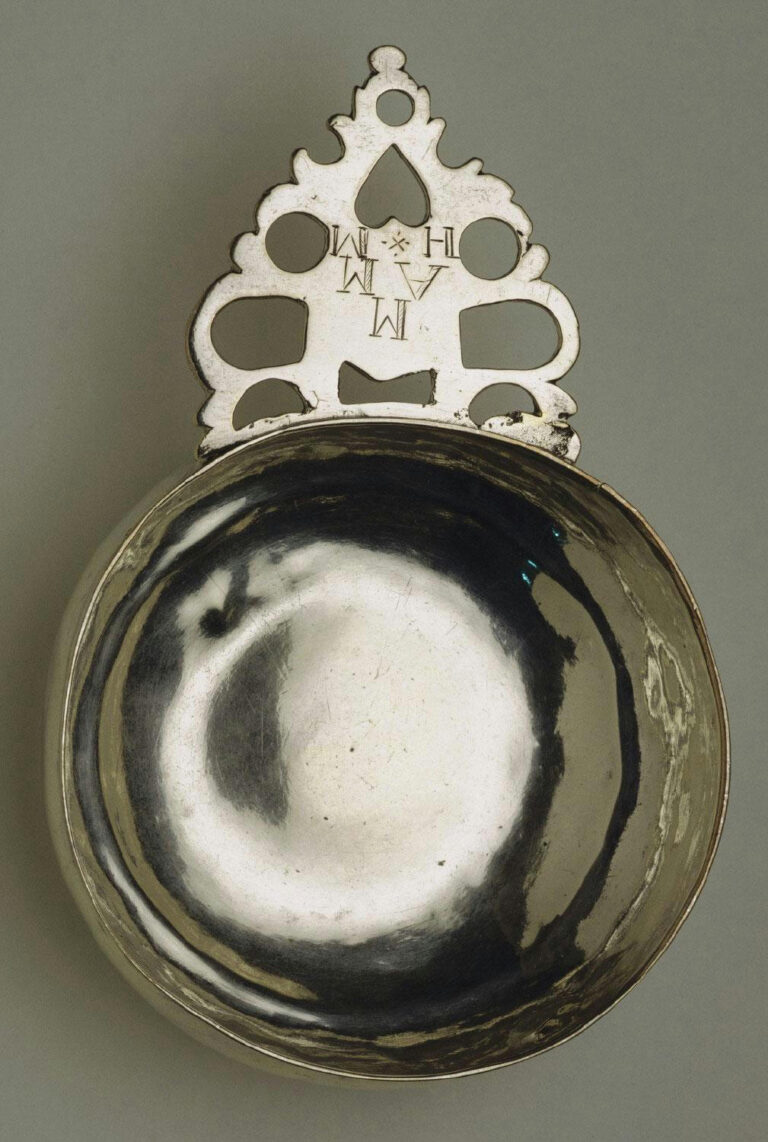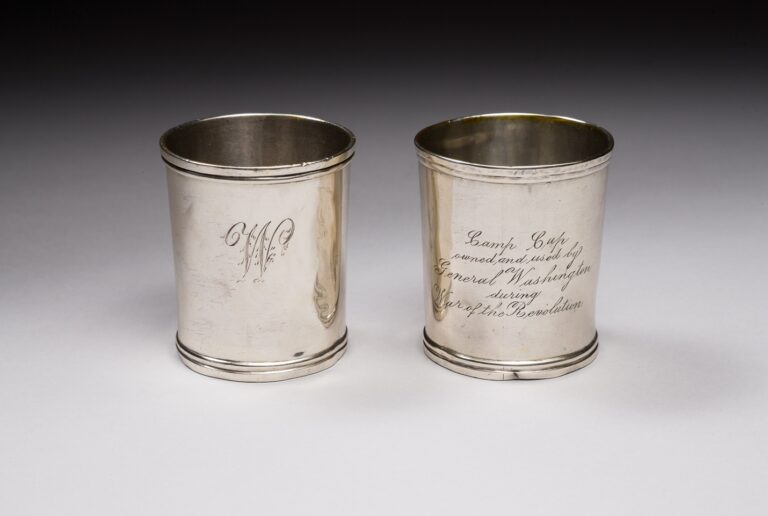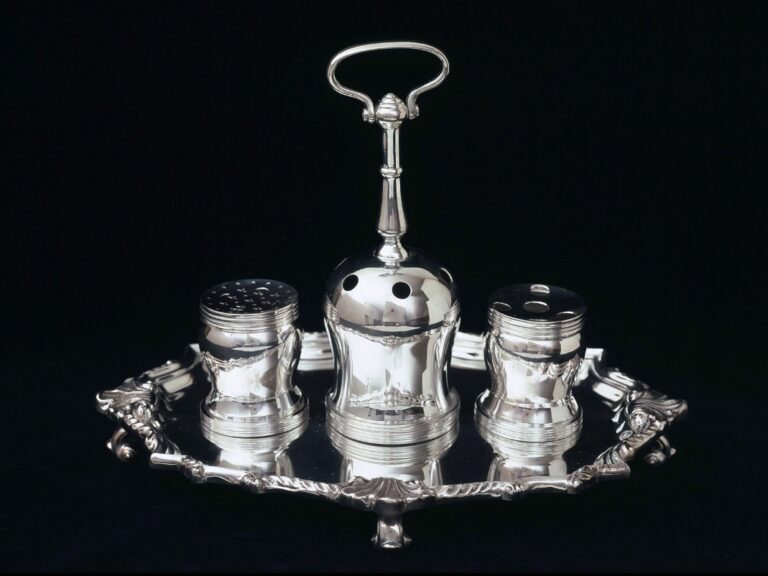Silversmiths
By Jack McCarthy | Reader-Nominated Topic
Essay
Philadelphia’s tradition of fine silver craftsmanship began in the late seventeenth century and was renowned by the mid- to late eighteenth-century, when city silversmiths produced exquisite pieces noted for their elegant design and expert workmanship.
Silversmithing as a profession in Philadelphia extends back to the 1690s. (Note that silversmiths were sometimes also called “goldsmiths,” as many of them worked with both metals. They will be referred to here as silversmiths, the craft for which Philadelphia was best known). No silversmiths were included in a comprehensive list of Philadelphia businesses compiled in 1690, but two “pewterers” were noted: Thomas Paschall (1634-c. 1718) and Thomas Langshaw (d. 1696). Pewter was easier to work with and much less expensive than silver; as such, it was a more practical metal for kitchenware, candlesticks, buckles, and other common items in the earliest years of Philadelphia’s settlement. As the city grew, however, so did the market for silver products.
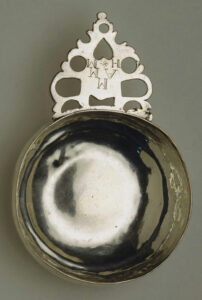
The earliest Philadelphia silversmiths on record were William Paschall (c. 1665-96, son of Thomas), Cesar Ghiselin (c. 1672-1733), and John (Anglicized from Johannis) Nys, (1671-1734), who appear as gold and silversmiths in wills and other documents beginning in the 1690s. Ghiselin and Nys, both French Huguenot immigrants, also appear in the account books of Philadelphia’s leading citizens in the early 1700s, providing gold and silversmithing services to men such as William Penn (1644-1718), James Logan (1674-1751), and prominent city merchants. By the 1720s, over a dozen silversmiths worked in Philadelphia. Most were located on or near High (later Market) or Front Streets, in the eastern part of the area later known as Old City, where the majority of the city’s businesses concentrated in the early years.
While local silversmiths produced pieces domestically, much fine silverware was imported into America in the first half of eighteenth century. The wealthy class often ordered custom silver from European (primarily English) craftsmen, while American silversmiths sold both items they imported and those they made in-house. Domestic silversmithing increased as the century unfolded and accelerated in the 1760s, when tensions with England spurred the production of homemade goods. Boston, New York, and Philadelphia were the primary American silver making centers in the colonial period. Because silver ore was not mined in the Philadelphia region, local silversmiths generally used coins or old silver pieces, which they melted down for raw material to craft new products. Sometimes the customers supplied these materials, although silversmiths also procured foreign coins from overseas merchants and sailors.
Silversmithing as a Family Business
Like many trades, silversmithing was a skill passed from father to son, giving rise to families that produced multiple generations of craftsmen. The Richardsons and the Syngs were the two most prominent families in the silver trade in colonial Philadelphia; between them, they gave the city its greatest silversmiths. Francis Richardson (1684-1729), the son of an English immigrant, moved as a child with his family to Philadelphia, where he became a silversmith. In 1701 William Penn paid him “for a paire of buckles for Letitia” (Penn’s daughter, 1678-1746). Richardson taught the trade to two of his sons: Francis Jr. (1705-82) and Joseph (1711-84). Francis Jr. moved to Chester, Pennsylvania (then the county seat of Chester County, later part of Delaware County), where he practiced silversmithing but focused primarily on other businesses. Joseph remained in Philadelphia and became a renowned craftsman, fashioning high-quality pieces for prominent families over a long career at his shop on the west side of South Front Street between Chestnut and Walnut Streets.
Two of Joseph Richardson’s sons also became silversmiths: Joseph, Jr. (1752-1831) and Nathaniel (1754-1827). After their father’s death in 1784 they took over his shop, running the business as J. & N. Richardson. Nathaniel later went into iron manufacture, while Joseph remained a silversmith. Like his father, Joseph Jr. had a long, prosperous career. In 1795 President George Washington (1732-99) appointed him Assayer of the U.S. Mint.
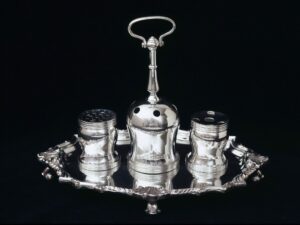
Philip Syng (the elder, 1676-1739), a gold and silversmith, was born in Ireland and immigrated to Philadelphia in 1714 with his family, which included his three sons: Philip Jr. (1703-89), Daniel (1713-45), and John (c. 1705-38), all of whom followed him in the trade. Philip Jr., like his contemporary Joseph Richardson Sr., became a celebrated silversmith, creating fine silver products for wealthy families and high-profile institutions from the 1720s until his retirement in 1772. His shop was on Front Street just below High (later Market) Street, a block from the Richardson shop. An inkstand Philip Jr. made in 1752 for the Pennsylvania General Assembly was believed to have been used by the signers of the Declaration of Independence and U.S. Constitution. It is on permanent display at Independence National Historical Park. Philip Jr.’s brothers worked as silversmiths in Philadelphia as well, although both moved to other cities and died young, as did Philip Jr.’s son, Philip III (1732-60), also a local silversmith.
Philip Syng Jr. and Joseph Richardson Sr. were distinguished craftsmen who catered to, and became part of, a wealthy class that emerged in Philadelphia in the mid-eighteenth century. Philadelphia was the largest, most prosperous city in British North America at this time, home to many families that could afford the finest in furnishings and housewares. In this era, before the establishment of banks, the upper class often invested in silver as a way to preserve their wealth, ordering custom-made tea sets, plates, bowls, and other items that, if need be, could be liquidated for cash, but which generally remained in the family for generations. The wills of wealthy eighteenth-century Philadelphians often stipulated the disposition of the family “plate,” as personal silver collections were known.
Pillars of the Community
Syng and Richardson were also prominent citizens who contributed to Philadelphia public life. Syng, a colleague of Benjamin Franklin (1706-90), participated in the latter’s civic, scientific, and medical activities and was a founding member of the city’s literary, scientific, and educational institutions. Richardson was a major landowner, merchant, and civic leader, and was active in the Religious Society of Friends. Their religious affiliations influenced their work. The Syngs made chalices for local Anglican congregations, while the Richardsons, due to their Quaker beliefs, would not make swords or chalices, but as members of the Friendly Society for Propagating Peace with the Indians through Pacific Measures, made ornamental pieces that were presented to Native American chiefs as gestures of friendship.

While the Richardsons and Syngs were the most notable, many prominent silversmiths were active in Philadelphia over the course of the eighteenth century. John Leacock (1729-1807), son of a pewterer, was a prosperous silversmith, civic activist, and revolutionary era patriot who was also noted for writing the 1776 play “The Fall of British Tyranny.” Daniel Dupuy (1719-1807) partnered with his brother-in-law John David (1736-98) and later with his two sons Daniel (1753-1826) and John (1747-1838) at the longtime family shop on Second Street near High (Market) Streets. Edmond Milne (1724-1822), a goldsmith and coin dealer who also had a shop on Second Street near High, did work for George Washington during the Revolutionary War, making a silver-hilted sword in 1776 that Washington gave to one of his officers, and a set of twelve cups in 1777 from silver dollars that Washington had provided. Milne also made ornaments and arm bands for a Pennsylvania Indian trader in this period. Richard Humphreys (1750-1832) took over Philip Syng Jr.’s business when Syng retired in 1772. Humphreys was also a successful merchant in the China trade and left an endowment to establish the Institute for Colored Youth in Philadelphia, which later became Cheney University of Pennsylvania. These are among the many dozens of eighteenth-century Philadelphia silversmiths documented in period account books, newspapers, directories, and tax lists.
Historians generally consider the mid- to late eighteenth century the high point in Philadelphia silver craftsmanship. The city had grown large and cosmopolitan by this time, but Quaker sensibilities still influenced the local aesthetic. While the craftsmanship was of the highest order, the designs were usually more modest, less ostentatious than those that prevailed in other cities.
Philadelphia’s preeminence in silversmithing ended in the early nineteenth century. Following the move of the federal capital from Philadelphia to Washington, D.C., in 1800 and the gradual shift of the nation’s financial sector to New York City in the years that followed, Philadelphia lost its status as the nation’s premier city, along with much of the wealth that had supported its high-end craftsmen. The establishment of a stable banking system precluded the need to commission fine silverware as a safe financial investment, while the emerging Industrial Revolution of the early nineteenth century signaled a fundamental transition from artisans making goods by hand to machine-based production in factory settings. Finely crafted, handmade products gradually gave way to cheaper, mass-produced goods.
Philadelphia still had wealthy families that supported skilled silversmiths, and the 1830s saw the establishment of two upscale family-run silver and jewelry businesses—Bailey, Banks, & Biddle and J. E. Caldwell & Company—that dominated the high-end Philadelphia market for generations, but the city was no longer the renowned center for silver artisanship it had been in the eighteenth-century. Exquisite pieces by colonial and early federal-era Philadelphia silversmiths that did not remain within local families were often sold at noted auction houses or exhibited in museums throughout the nation.
Jack McCarthy, at the time of publication, was an archivist and historian specializing in writing, lecturing, and giving tours in three areas of Philadelphia history: music, business and industry, and Northeast Philadelphia. His book In the Cradle of Industry and Liberty: A History of Manufacturing in Philadelphia was published in 2016, and he curated the 2017–18 exhibit Risk & Reward: Entrepreneurship and the Making of Philadelphia for the Abraham Lincoln Foundation of the Union League of Philadelphia. At the time of publication, he served as consulting archivist for the Philadelphia Orchestra and Mann Music Center, and he previously directed the 2018-19 project Documenting & Interpreting the Philly Jazz Legacy, funded by the Pew Center for Arts & Heritage.
Copyright 2022, Rutgers University
